Anglers Booking Team
The expert copywriters at Anglers Booking have meticulously crafted this article. Our dedicated team of writers provides valuable insights and information to enhance your angling experience.
 11 minutes read
11 minutes readIn the dimension of coastal fishing, two types of fish stand out and have long held the attention of fishing enthusiasts and professionals: the colorful Speckled Trout and Redfish.
Both fish are attached to relatively similar habitats but have opposing personalities. The stunning Speckled Trout is known for its elegant appearance, quick reaction, and fine, refined combativeness, while the Redfish amazes with its strength, persistence, incredible abundance, and easy adaptation!

Although their differences seem clear, let's take the game to the next level and introduce these shallow-water darlings in more detail! In the Speckled Trout vs. Redfish comparison, we will explore their physical characteristics, habitats, and seasonal activities in depth.
We will also explore the delicious differences in meat that make these fish as popular on the plate as they are in the water. So get ready to discover what makes these fish so unique!
Both species stand out for their unique traits, offering anglers different challenges and rewards. From appearance and habitat to how they respond to bait, Speckled Trout and Redfish each have distinct styles. Let's explore what sets them apart.
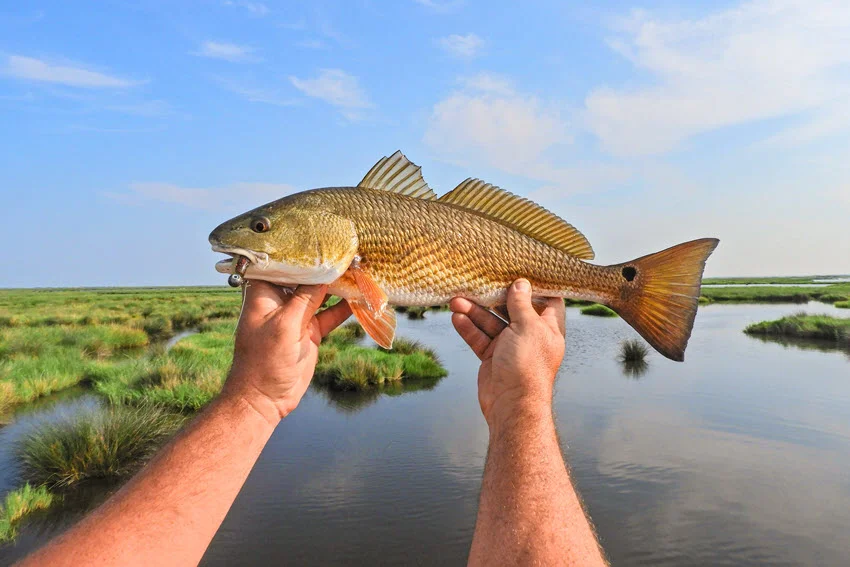
The differences in size and weight are as clear as day! Speckled Trout typically grow to 14 to 24 inches and weigh between 1 and 5 pounds, although trophy specimens can exceed 30 inches and reach 10 pounds or more.
In contrast, the Redfish is considerably more prominent, with 18 to 27 inches in length for the younger fish, the so-called slot sizes that are most common and hunted. However, for those chasing trophies, there are primarily large specimens, known as "Bull Redfish," which can exceed 40 inches and weigh over 30 pounds.
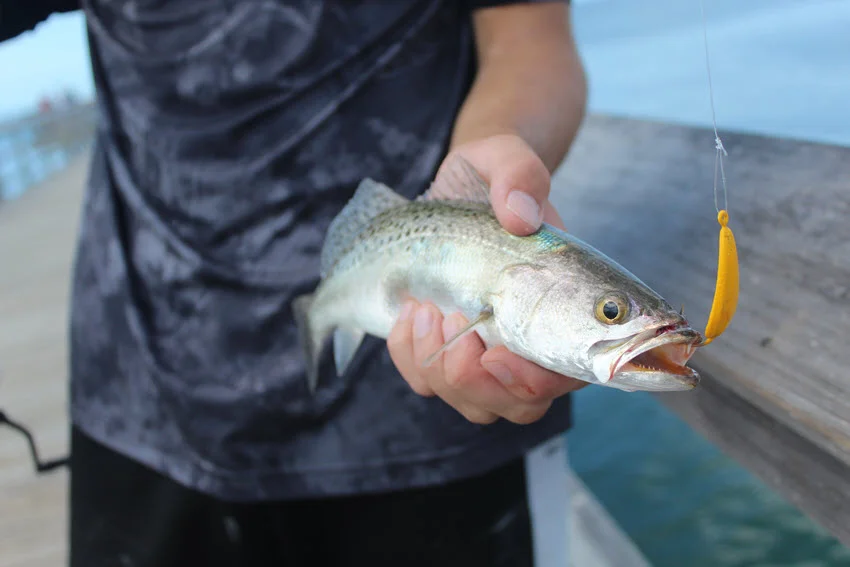
The colors and patterns give both fish their striking and unique appeal. Thus, the Speckled Trout, or Sea Leopard, is recognizable by its silvery-grey color, greenish tones, and dark spots throughout the body. This gives the otherwise long body an even more specific and elegant look. The dots are often spread over the back and sides, creating an easily recognized pattern that serves as a camouflage defense.
Redfish, according to its name, have a copper or reddish shade of body with a striking black spot, usually located near the tail. Some may even have multiple spots, and one theory is that this spot serves to confuse predators.
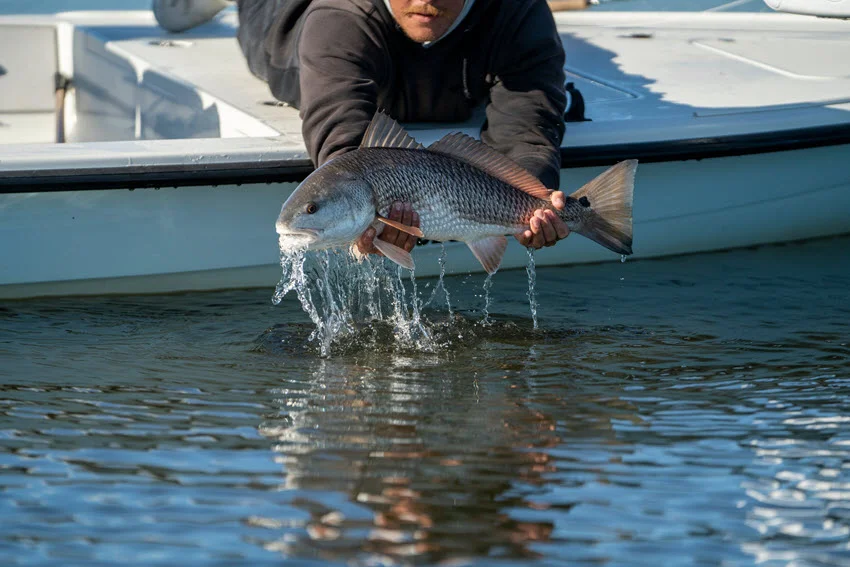
Speckled Trout and Redfish have fascinating life paths that add even more to the popularity of these fish. Speckled Trout can live between 5 and 10 years, sometimes up to 12 years. They reach maturity quickly, already around the second year, which makes them a frequent and desirable catch due to their combativeness and attractive appearance.
Redfish live much longer, averaging around 20 years and sometimes over 40. This gives them time to grow large, especially the prized "Bull Redfish." They're powerful fighters and highly adaptable, thriving in everything from shallow bays to deeper coastal zones.
Speckled Trout and Redfish both thrive in coastal habitats, but in different ways. Trout prefer calm bays, estuaries, and shallows, where they blend into seagrass while chasing small fish and crayfish. Redfish roam wider areas, from sandy shores to swamps and river mouths, showing off their adaptability.
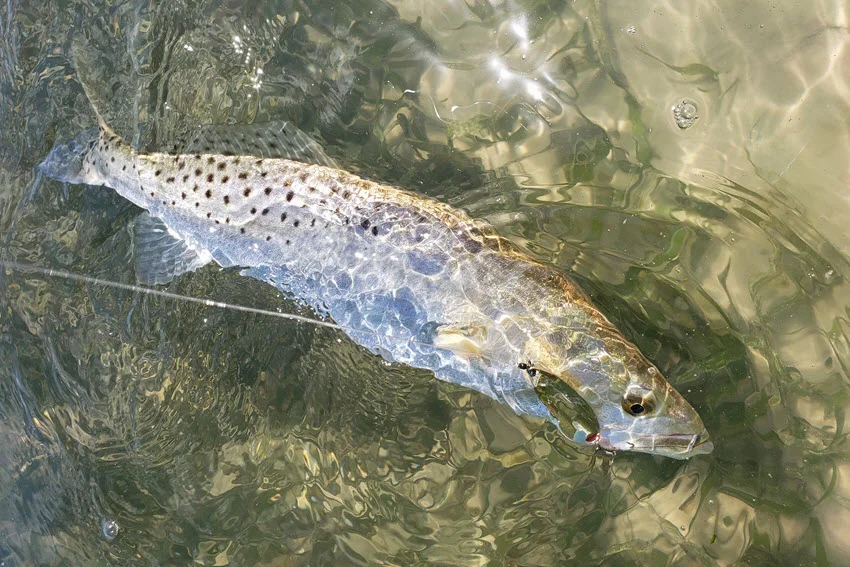
Both fish are relatively easy to find in various coastal areas. Speckled Trout prefer calm, shallow bays, estuaries, and lagoons with plenty of seagrass or muddy bottoms. They thrive in salt and brackish waters along the Atlantic coast and the Gulf of Mexico, especially where water temperatures stay warm year-round. They're most active in the early morning and late evening.
Redfish are highly adaptable and can be found in various environments, from sandy coves and swamps to mangroves and river mouths. Younger Redfish stay closer to shore, while larger "Bull Redfish" often move into deeper coastal waters, especially during the fall spawning season.

Speckled Trout and Redfish adjust their activity based on water temperature and food availability. Trout are most active in spring and fall, moving to shallow, food-rich areas, but retreat deeper in summer. Redfish are active year-round but peak in fall during their spawning season.
In spring, both Speckled Trout and Redfish become more active as water warms and food becomes abundant. Trout move into shallow estuaries and bays, while Redfish roam wider coastal zones, often schooling and feeding heavily, making this one of the best times to catch both.
Summer is the peak season for both species. During the warmer months, Spotted Trout stay in the shallows, moving in larger groups and offering great fishing opportunities on calm shores. As for Redfish, summer is beautiful for those who like Bull Redfish, which is a real challenge for experienced anglers and those looking for an intense fight.
When the temperature drops, the Speckled Trout retreats to deeper waters, preparing for winter, but remains active in the coastal areas. The same goes for Redfish, which continue to explore the inshore areas, but as the weather cools, their activity decreases. You can still catch both fish, but with more patience and precision.
During the winter, the Speckled Trout moves to deeper and warmer waters, where it remains relatively active. Redfish also conserve energy in colder conditions, but are still relatively easy to find in tropical and subtropical regions. Both fish still offer good catch opportunities for persistent anglers, especially in mild winter areas.

There are many places where you can target Speckled Trout and Redfish year-round, especially in tropical and subtropical areas around the Gulf of Mexico. However, spring and fall are generally the best seasons, as both species become more active with warming waters and plentiful food.
Speckled Trout peak in spring as they begin feeding heavily, and again in fall during their transition between coastal and deeper waters. Redfish are most active in summer while cruising the coast and reach their peak in fall, when larger, spawning-age fish, especially Bull Redfish, are easier to find.
Spotted Trout and Redfish have interesting feeding habits, leaving plenty of room for bait selection. Spotted Trout prefer smaller fish, crabs, and shrimp, while Redfish actively explore the bottom in search of crabs and shellfish, adapting to different types of prey.
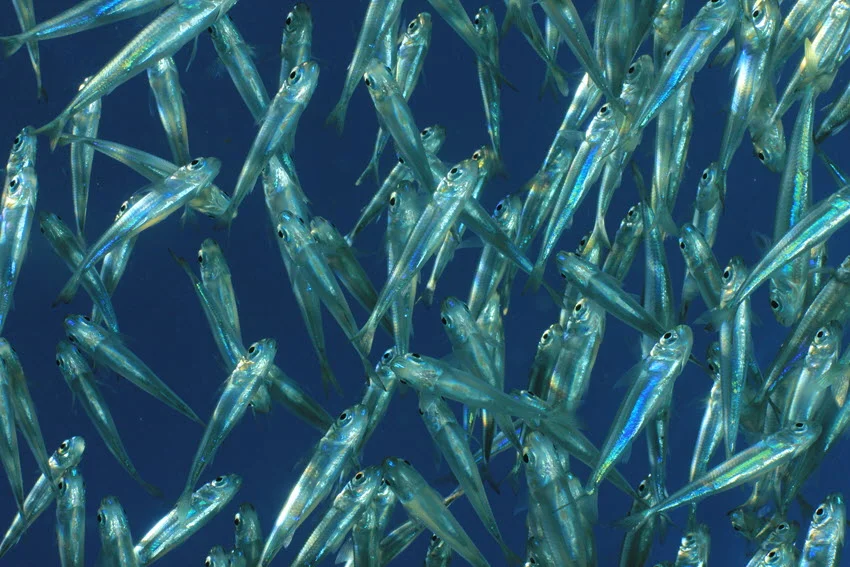
Speckled Trout is very selective about nutrition, but even as such, its menu includes a wide range of marine prey, and it also has specific favorites. Thus, it prefers small fish such as sardines, herrings, and young mullets because they provide high energy.
The Speckled Trout uses its hunting skills from an ambush hidden among the seagrasses or the sandy bottom. Its dietary preferences often vary throughout the year, depending on food availability and the season, and it is happy to catch crabs and shrimp.
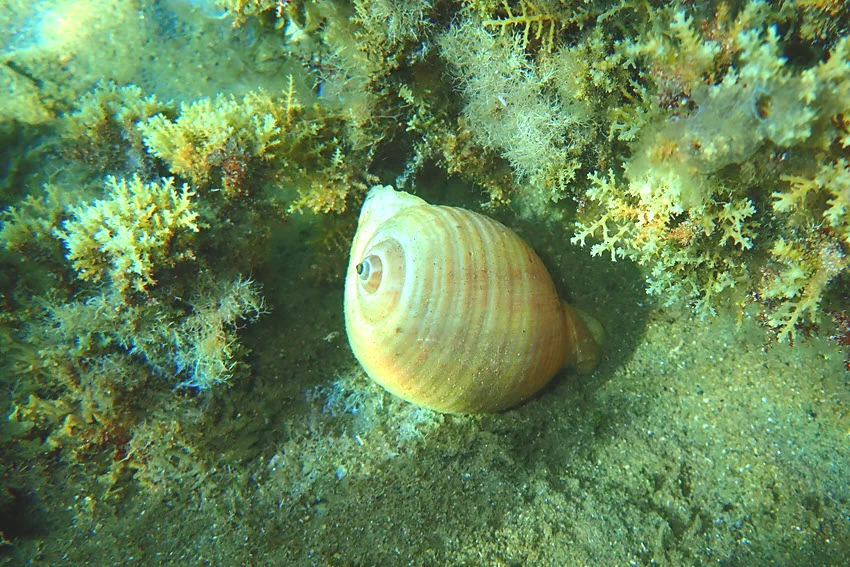
In contrast to the selective Speckled Trout, the Redfish has a very adaptable appetite and feeds on various prey that live on or near the bottom of the sea. The Redfish menu includes crabs, prawns, clams, and small fish such as mullet and mackerel because its strong teeth are perfect for crushing the shells of crabs and clams.
This species loves to scour the seabed, using its conspicuous red gills and tail to dig up food. It feeds most intensively during summer and fall when crabs and shellfish are plentiful. In fall, during spawning, the Redfish becomes even more active, adapting to its environment's wealth of resources. It's not very picky when life is at stake.
You can catch Speckled Trout and Redfish using various techniques from different coastal areas or boats. Their accessibility and possibility of experimentation make them popular because they are suitable for relaxed and action-packed fishing. Here are some of the best techniques for both types and tips on adapting them to the environment.
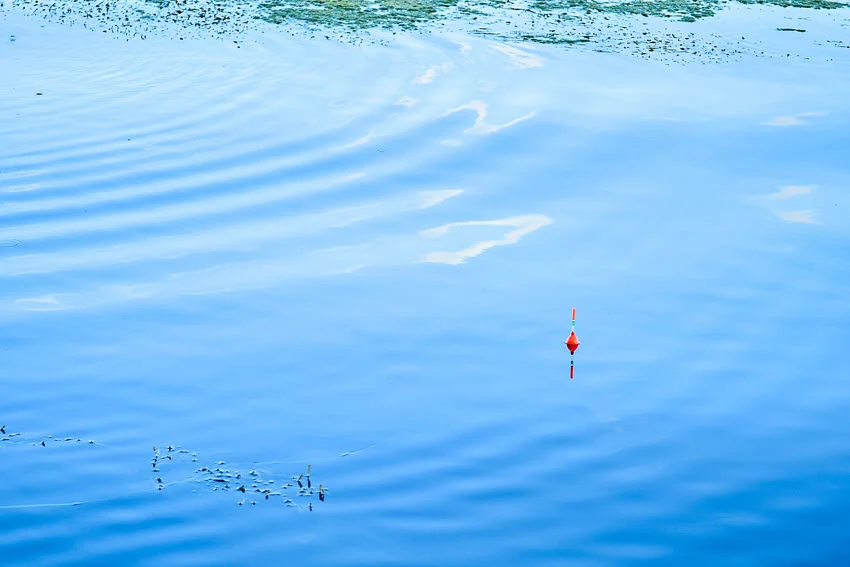
Although readily available from the coast, catching Speckled Trout is not always easy. Success depends on light, natural bait presentation, as these fish often hunt from ambush and react best to prey that moves smoothly through the water.
Jig heads with soft baits that mimic shrimp or small fish are highly effective, especially in bays and marshes during spring and fall. Topwater techniques using noisy baits like poppers or walk-the-dog lures also work well, particularly in the early morning. For less active Trout, live bait such as prawns or small mullets can be a great choice, especially in estuaries and grassy flats.

Techniques for catching Redfish must be adapted to its intense and persistent fighting style. Bottom fishing with heavier baits, such as live crabs, clams, or prawns, is one of the safest methods for catching this red beauty. This approach works best in shallower, muddy, sandy coast areas and estuaries, especially in spring and summer.
Many anglers love popular sight fishing, especially when it is closer to shore in shallow waters. Sight fishing involves a quiet and careful approach to spotting a fish before setting up easy-to-see lures or soft plastics. Spin fishing with topwater baits is also practical because Redfish can be caught in topwater action, especially if the bait makes a noise that intrigues them, such as "poppers" and "spooks."
Both fish require a specific approach regarding rods, reels, and types of bait. Although they live in the same area, their behavior and habits differ considerably. From lighter rods for a subtle approach to Trout to more powerful tools for fighting Redfish, let's look at the essential elements of fishing gear for these popular and demanding species.

Speckled Trout mostly live in shallow and medium-deep waters and, therefore, require more delicate and precise gear, which enables detailed control of the rod and line. Here is our idea of how your fishing setup should look:
Due to their lively and complex nature, gear must be light, durable, and adapted to their particular behavior to touch their specific nerves and lure them out of the shelter. Therefore, a good presentation that is very well aligned with their food preferences is essential.

Redfish are known for their fighting spirit, which means you need robust and reliable gear to be successful. Considering that Redfish usually settle in coastal water and search for prey in mud and sand, our gear recommendation for this species is as follows:
The key to success in fishing for these species is being strong, durable, and ready to withstand the challenges this fish presents; that is, having the perfect balance of flexibility and firmness.
These fish beauties differ in taste and how they enrich the dish. A colorful Trout comes with its mild, sweet meat that absorbs spices, while Redfish is a much juicier and fattier fish bite that goes well with bolder spices.

Speckled Trout has a mild, sweet-fruity taste with delicate tones of sea salt. It is suitable for faster preparation methods that preserve natural texture and juiciness. It is often prepared by frying in a pan, previously coated with olive oil, salted, and seasoned with fresh herbs such as thyme or parsley.
Then, grilling with light marinades of lemon, garlic, and olive oil will further enhance its sweet note without covering the natural flavor. The meat absorbs spices quickly, and simple additions, such as fresh vegetables or sauces based on wine and capers, perfectly complement its profile.

Redfish has a bold, distinctly fishy flavor that appeals to those who enjoy stronger marine tastes. Its firm texture makes it ideal for cooking methods that highlight structure and allow deeper spice absorption. One of the most popular ways to prepare Redfish is blackening, coating the fillet in butter and spices like paprika, garlic, and cayenne pepper, then searing it at high heat to form a flavorful, crispy crust.
It's also commonly grilled with olive oil, lemon, and herbs like rosemary or thyme, or baked in foil with vegetables to lock in moisture. Redfish pairs well with hearty sides such as baked potatoes or fresh salads, delivering a rich coastal flavor in every bite.
Considering that neither species is boring and you can get to know them at different levels, both beginners and experienced anglers can find enough challenges. And what exactly makes them unique? Find out below.

Speckled Trout and Redfish are suitable for beginners as they offer a mixture of challenge and excitement. They will help beginners sharpen and test their skills while providing an exciting catch and introduction to the sport.
Given that it is relatively easily accessible, delicious, and quite a fighting opponent, it is clear why it is so attractive to beginners.
Why choose Speckled Trout?
Trout is a great way to practice self-control, patience, and precision. In addition to the fight and meat, these are the main reasons it is so popular.
The Redfish is a significantly greater fishing challenge and a little more complicated. It is more combative and durable, perfect for those who want to improve their fishing skills.
Why choose Redfish?
Thanks to their accessibility and rewarding fights, Redfish and Speckled Trout offer beginner anglers the perfect mix of learning and excitement.

For those with a bit more fishing experience, these fish are primarily an opportunity to practice and perfect different techniques and experiment with location selection.
Speckled Trout are relatively small fish, but they are often tricky to catch. This means that without precision and sound strategy, you will have difficulty catching them.
Why choose Speckled Trout?
A true beauty, this fish traditionally attracts with its slightly mystical aura and the fact that it requires a very subtle approach.
For experienced anglers, Redfish cannot be boring. They are strong opponents capable of prolonged, intense battles and a real inshore fishing spectacle.
Why choose Redfish?
Speckled Trout and Redfish are two species you can almost always count on, but no matter how many times you fish them, they present a different challenge.
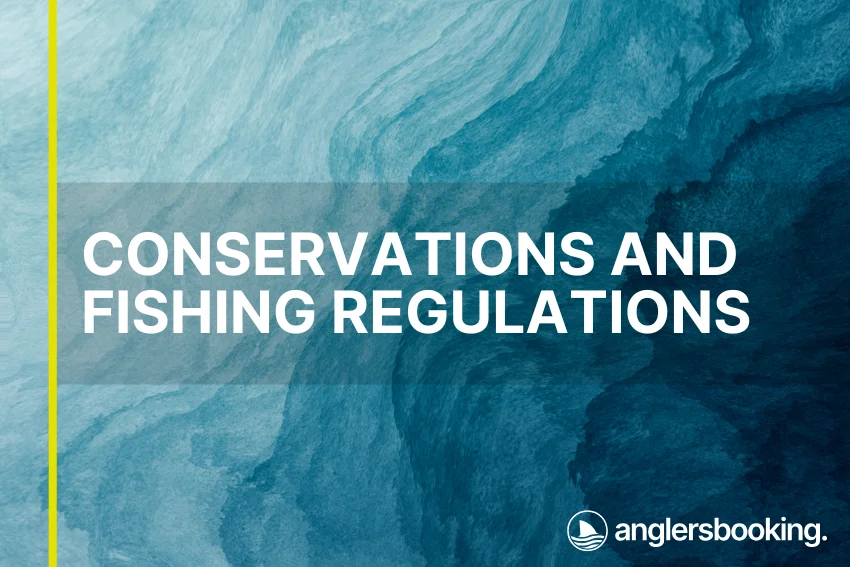
Understanding fishing regulations and preserving specific fish species contributes to protecting fish populations and ecosystems and promoting responsible angling practices.
Anglers Booking Team
In general, Speckled Trout and Redfish populations are not threatened, but in most regions, both species are subject to seasonal closures, bag limits, and size restrictions. In this way, their populations are controlled and maintained.
These regulations are constantly updated based on population assessments and ecological factors. Anglers are always encouraged to practice responsible fishing and check local laws before casting a line.
Current efforts for these species focus primarily on habitat protection and monitoring population numbers. Accordingly, many coastal states have enacted regulations regarding size limits and spawning season bans for Speckled Trout.
Habitat conservation, ongoing monitoring, and research programs that assess population health and adjust regulations are equally important.
Anglers can contribute to conservation efforts by raising awareness of the fragility of these fish's habitats. They must follow local regulations and have all necessary permits, and they can practice catch-and-release, especially for large or small fish.
Anglers can also support conservation organizations like the Coastal Conservation Association (CCA), which works to preserve and improve coastal and marine habitats through advocacy, research, and restoration projects. Also, it is a good option to participate in habitat restoration projects.
Although they live in very similar areas, Speckled Trout and Redfish are specific in their way, which shows how unique each species is in the fishing world. Speckled Trout tests finesse and precision, while Redfish brings an intense, powerful battle.
If you are a more active angler, you have already encountered these fish and know a trick or two, or you have an interesting story, which we would love to read in the comments below. Write about how you experienced these species, which is the better catch, and why. We look forward to your comments!

The expert copywriters at Anglers Booking have meticulously crafted this article. Our dedicated team of writers provides valuable insights and information to enhance your angling experience.
Embark on unforgettable fishing adventures with us at Anglers Booking.
book your charterOctober 17, 2025
October 15, 2025
October 10, 2025
October 11, 2025
October 4, 2025
September 29, 2025
September 25, 2025
September 21, 2025

You're now part of our exclusive community. Get ready for premium content and updates straight to your inbox.
close
Subscribe to our newsletter and receive a selection of cool articles every week.
Please enter a valid email address.

Be the first to know when we're back in action.
Please enter a valid email address.
Leave a Comment
Your email address will not be published. Required fields are marked *
Thank you for your comment! It has been submitted for review and will appear on the site shortly.